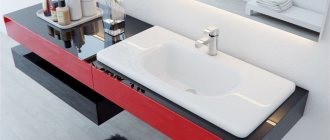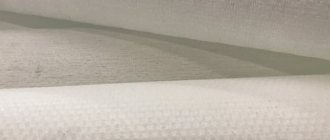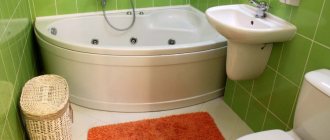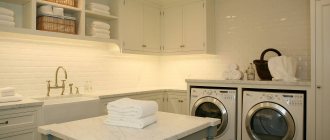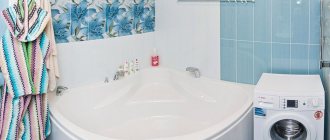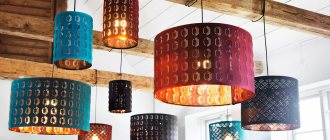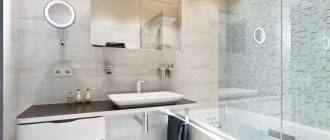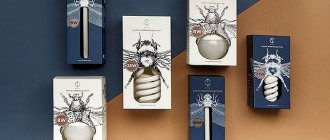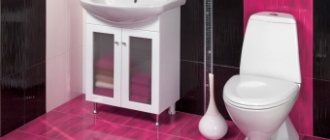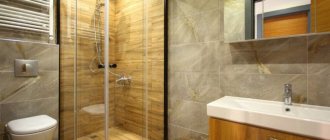Click to share
more
Decorative LED lighting for shelves and niches, illuminated bathtubs, shower cabins or mirrors are just some of the many possibilities for placing LED strips in the bathroom. In many cases, they are not only decorative, but also practical.
Thanks to them, you can create an interior that looks more like a bath salon or even a small home spa than a regular bathroom. Light of different shades, intensities and even colors coming from different spaces of the room is a wonderful modern, elegant and effective addition to bathroom fixtures.
As you might guess, stores offer a huge selection of LED strips for use in various interiors. What to choose for the bathroom? Here are some tips!
Shower stalls and bathroom lighting
Calculating the lighting of a bathroom if it has a shower stall has its own nuances. After all, usually Soviet bathrooms do not require the presence of such large products, and the light bulbs above the entrance to the bathroom are not enough to illuminate the stall.
In this regard, the question arises: how to create additional lighting directly above the shower stall. This question is especially relevant when the ceilings of the room are low and any lamps located above the shower will be located unacceptably close to the water flow.
The most expensive bathrooms
Unfortunately, it was not possible to find the exact cost of expensive rooms (with one exception). However, the following are considered the most expensive bathrooms.
Shangri-La Hotel (Istanbul). There is a TV built into the mirror.
7-star Burj Al Arab hotel.
Parisian castle Chateau Louis XIV.
Room with a window at the Ritz-Carlton Hong Kong (China).
A mansion in California boasts a $9.9 million bath.
If we take an indispensable attribute of any room - the bathroom itself - then they are also made from a variety of expensive materials.
Fossilized Indonesian wood over 180 million years old.
Made in a single copy. Price: $1,740,000. It belongs to a certain billionaire from the United Arab Emirates.
The billionaire does not advertise his name, and rightly so. After all, the owner of another expensive gold bathtub lost it. The gold container was simply stolen from the Japanese Kominato Hotel. And it cost $990,000 and weighed 86 kg.
Golden bath
The original rock crystal font is the heaviest. It was made in three copies. Two of them were sold: to a Russian oligarch and an Italian socialite. The cost of the plumbing was $790,310. The third copy is still for sale.
Crystal Font
Relatively inexpensive, but very beautiful bathtubs are made of amethyst and malachite. They cost $122,000 and $222,000 respectively. They also have legs made of gold.
Requirements for bathroom electrical equipment
Before thinking about how exactly to organize lighting for a shower stall, let's figure out what, strictly speaking, standards apply to bathroom electrical equipment? In this matter, we will rely on GOST R 50571. 11 - 96, which standardizes electrical installations of buildings, as well as the rules for the design of electrical installations - PUE.
So, according to these regulatory documents, the entire bathroom area is divided into 4 zones.
Each of these zones has its own requirements for electrical equipment:
It is limited to the internal cavity of the bathtub, shower tray or washbasin. This is where water can accumulate and even be stored. Therefore, any electrical installations located in this place are, in fact, in the water.
Based on this, if they are located here, then only with the appropriate protection class. PUE standards require that devices with a water ingress protection class of at least 7 be installed here.
It is limited by conditional vertical planes from the edge of the bathtub, washbasin or shower tray upward to a height of up to 2.25 meters. For a shower stall, this is, in fact, its entire internal cavity.
The instructions require that devices with a moisture protection class of at least 5 be used here. Usually only water heaters are located here.
It is limited by conventional vertical planes at a distance of less than 60 cm from zone 1.
Here it is already allowed to install not only water heaters, but also lamps. Protection against moisture penetration of such lamps must be at least 4.
It starts 60 cm from zone number 1, and extends to the rest of the bathroom.
Here you can already install sockets, lamps and any other electrical equipment without special protection from moisture penetration.
Note! When we say: class of protection against moisture penetration, we mean the world standard. It is usually marked on the product itself. It is designated as IP followed by two numbers. The first number indicates the level of protection against dust ingress. The higher it is, the better the protection. The second number indicates the level of protection against moisture. In total there can be from 1 to 8. The higher the number, the better the protection against moisture.
Connecting the shower cabin to the electrical network
If a ready-made model purchased from a plumbing store is installed, then it is made as a single electrical appliance. The manufacturer has already taken care of the functionality of all the electrical components of the box, and during installation you just need to connect it to electricity. This stage is the final one, first you need to:
Each model has its own assembly features, which are described in detail in the instructions; if you follow its recommendations, then installing the shower stall should not cause much difficulty.
Bathroom lighting for shower stall
Based on the requirements of regulations, lighting for a shower stall can be implemented in two ways - by creating a 12V network with installation directly inside the stall, or by increasing the general lighting in the bathroom. Let's look at each of these options separately.
12 V network for lighting the shower stall
The most correct way from the point of view of economy, safety and, of course, rationality is to create an additional 12V network. From this network we will power the lamps installed directly inside the shower stall.
To do this, we first of all need 12V lamps themselves, with an appropriate design for the level of protection against moisture. Nowadays there are quite a lot of different models on the market.
These can be built-in, side or directional lamps. The price of such products depends on their type, but is usually at a very reasonable level.
Note! Switches in zones 1 and 2 may only be installed if they are cord operated.
Based on this, it is better to turn on the lighting for the shower stall with a switch installed on the 220V side. But in this case, it should be located at least in the third zone of the bathroom.
Increasing general bathroom lighting
According to SanPiN 2.2.1/2.1.1.1278-03, the recommended level of illumination in the bathroom should be 50 lux. Moreover, the standardized surface is the floor of the room. But when installing a shower stall, even this obviously low indicator may not be met. In this case, you will need additional lighting in the room.
Remember! If you choose side lighting, then you should install at least more than one lamp in one room. Moreover, it is highly desirable that they be located in opposite parts of the room. Ideally, you should install 1 lamp on each wall. Otherwise, if there is a person in the room, there will be high shading of objects opposite the lamp.
When lighting a bathroom, lamps should be chosen with a closed lamp. The design must have adequate protection against moisture penetration, and the material must be resistant to high room humidity.
bathroom wall covering instead of tiles
Electrical wiring should be installed in a hidden manner. In this case, cables with a metal braid cannot be used. Junction boxes, as well as lighting controls, should be located outside the bathroom.
Types of lamps
Bathroom lamps are available with all the usual types of lamps. But not all types are well suited to wet rooms.
Incandescent
Not the best solution for a bathroom. Suitable for use only in the last zone, farthest from water, splashes. A sealed protective cover is required.
pros
- low prices;
- widespread in stores;
- resistance to voltage surges.
Minuses
- fragility, mechanical instability;
- strong heating during operation: up to approximately 250⁰ C and higher. Accidental entry of moisture will result in an explosion;
- short service life (1000 hours);
- They only shine with warm light.
LED
Most suitable for damp areas. Available in the form of lamps, spots, and strips of different designs. Their use is possible in all areas of the room.
pros
- moisture resistance;
- efficiency, energy saving;
- environmental Safety;
- absence of strong heating of the lamp: LED heats up to approximately 60-80⁰С;
- variety of glow colors, color temperatures;
- long service life (approximately 30,000 hours and above);
- Possibility of programming lighting modes.
Minuses
- high price;
- decrease in brightness over service life due to physical degradation of LEDs;
- reduction in manufacturing quality due to high competition among manufacturers and the desire to reduce prices.
Halogen
Can be used as spotlights with the appropriate protection class. In areas directly in contact with water, it is better to install a low-voltage version of lamps: with a supply voltage of 12 V. Acceptable, but not the best option.
pros
- relatively low price;
- good quality of light;
- variety of shapes and appearance of lamps.
Minuses
- short service life (2000-4000 hours);
- sensitivity to voltage changes in the network;
- strong heating during operation: up to 300⁰С.
Luminescent
The worst option for use in the bathroom. Fluorescent lamps are afraid of high humidity and frequent switching on and off, which is typical for the bathroom. Other disadvantages worth noting:
pros
- long service life (10,000-15,000 hours);
- save energy;
- have a variety of color temperatures.
Minuses
- environmental hazard due to the presence of mercury vapor in the composition;
- difficulties with recycling used lamps;
- sensitivity to voltage changes in the network.
Lighting in the bathroom: combining safety and aesthetics
In city apartments, it is sometimes difficult to implement design ideas borrowed from foreign glossy magazines. This is due to limited space, the state of engineering structures, and a small limit on energy consumption. It is impossible not to take into account the high percentage of defects during construction. The communications device also does not always meet accepted standards. The situation is aggravated by the fact that over the past few years many non-standard electrical and plumbing fixtures have appeared that are not designed for standard housing. Despite these problems, there are many design solutions for standard apartments and luxury new buildings. In this article we show what lighting can be like in a bathroom: examples and photos.
The best options for bathroom fixtures
To choose a suitable lamp, you need to decide what area it will illuminate. If the light is distributed throughout the room, it is better to choose a device with bright diffused light - a pendant or overhead product.
For a room designed in a minimalist style, built-in point light sources are suitable. Near the bathtub, sconces, floor lamps, lamps with adjustable beam direction, and pendants are installed.
When choosing a lamp for the bathroom, you should consider the following rules:
1. Experiments with a lampshade decorated with a pattern may end in failure. A matte light and monochromatic lampshade is the best solution.
2. It’s good if the device has maximum color rendering. Looking in the bathroom mirror with such lighting is a real pleasure.
3. It wouldn’t hurt to adjust the brightness of the product, adaptable to different application tasks.
Proper lighting in the bathroom
Each building has its own characteristics. In some of them, in order to secure a screw for a lamp, you need to cement it - neither dowels nor plugs will hold in a crumbling wall. It happens that communications are laid with errors. In old buildings that have not undergone major renovations for a long time, the wiring requires replacement. Before starting work, you need to make sure that everything is working properly, or bring the electrics into proper condition. To do this, it is better to use the services of an electrician.
What not to do
There are prohibitions for the entire premises and for its individual zones.
Restrictions according to GOSTs and SNiPs
Prohibited activities are listed in local regulations. These lists may differ in different regions, but basically they are the same. For Moscow, Resolution No. 508 PP applies. According to this document, it is prohibited to lay grooves in reinforced concrete slabs and interpanel joints. Channels can be laid in the finishing or under a suspended ceiling or plasterboard sheathing of a metal frame.
Some restrictions are introduced by GOSTs and SNiPs. Technical standards prohibit open wiring. You can only use a triple wire with a phase, neutral and protective conductor. Each of them must be in its own protective shell. All three wires are connected together under an additional layer of insulation. The use of metal coating without insulation is not permitted. For laying, corrugated or plastic pipes should be used. Metal ones cannot be used. If the cable is damaged, such a coating will not be able to protect against electric shock. The use of electrical tape is not permitted.
It is prohibited to place switches, electrical panels and distribution boxes in the bathroom. Sockets and all devices must have a residual current device (RCD). There are special models for wet rooms. All equipment must be grounded. To minimize the risk, even a bathtub can be grounded if it is made of steel or cast iron.
Under no circumstances should you do grounding yourself by connecting a wire to a heating radiator or water pipe. This can be dangerous to life and health.
According to the Civil Code of the Russian Federation, any changes that require inclusion in the technical passport and BTI plan require the creation of design documentation. Only an engineering organization with SRO approval can draw up a project. Documentation must be approved by government authorities. The installation of lighting, as a rule, cannot be classified as a refurbishment, but it may be part of a plan that requires a number of changes to be made to the layout and energy supply of the apartment.
Restrictions for individual zones
Lighting in a small bathroom, as well as in a spacious room, depends on areas with different degrees of humidity. Four sections can be distinguished:
Source
What should be the lighting in the bathroom?
First of all, it is important to think through the installation scheme and evaluate the light distribution zones. There should be enough, but not too much: excessively bright rays will spoil the overall impression of the design.
You need to focus on:
The bathroom has several functional areas: a bath or shower, a sink with a mirror and a free area where you can change clothes and put things away. Sometimes designers offer options for illuminating shelves in a wall cabinet, and for a spacious room - cabinets, hangers and even full-fledged cabinets.
General recommendations
The bathroom needs bright light
Good, bright background lighting is recommended for bathrooms. The minimum standard illumination according to SNiP and SanPiN is 300 lux.
Remember that the light level is affected by the color, material of the walls, floor and ceiling. Dark, rough surfaces absorb light, while smooth, light surfaces reflect. Moreover, reflected light from the walls and ceiling visually enlarges the space.
For bathrooms, especially large ones, it is important to illuminate the functional areas separately from each other.
Soft diffused lighting of shelves, bedside tables, and cabinets will add additional comfort and make it easier to find the things you need.
The size and design of the lamps must match the size and design of the interior.
Bathroom ceiling lighting
The simplest option is ceiling lighting. In traditional Soviet apartment design, lighting was a single lamp located in the center or above the entrance. If the room is small, this can still be considered the necessary minimum. But modern small chandeliers and built-in ceiling lamps will not take up much space, while making the use of the room more convenient.
butterflies in the country looking like moths
Much depends on what you do in the bathroom: the functionality of the room is limited to hygiene procedures, or you like to read while immersed in water, or maybe this is where you get ready for work and clean yourself up in front of the mirror. You need to take into account the habits of all family members, think through possible scenarios and from here build a lighting scheme for everyone’s comfort.
Shower lamp: features of selection and connection
The presence of lighting in the shower room or cabin will allow you to take water procedures with greater comfort. But in the process of its implementation, it is necessary to remember the dangers of combining water with electricity.
In the article we will look at all the necessary safety measures, as well as step-by-step implementation of this task with your own hands.
Photo of an illuminated shower stall
Bathroom mirror lighting
As a rule, it is the mirror that requires good lighting. Therefore, designers recommend purchasing models with built-in lamps. You can install external LED lighting to an existing mirror without lamps. It is usually mounted on two or four sides of the frame.
A good solution could be an LED strip around the perimeter of the mirror. There are models on the market with the ability to change brightness and color modes. It is worth paying attention to flexible neon - PVC cord equipped with diodes. It can be installed on the side of furniture, on walls, cornices or on the floor. To avoid glare on the glass, light sources external to the mirror should be placed perpendicular to its reflective surface.
Ceiling lighting
LED strips can also be mounted under the bathroom ceiling, around or behind the mirror, on furniture, shelves and walls. At the same time, surface glow ribbons are used to illuminate the ceiling, mirrors and shelves. They are mounted in such a way that the eye cannot see them.
So, if the ceiling is illuminated, then the LED strip is hidden behind the ceiling plinth. This plinth should be on the wall and the distance to the ceiling should be five centimeters. The baseboard can be plastic or aluminum and must be secured with self-tapping screws.
Bath or shower lighting
The same LEDs will help create a light accent in the shower or bath. The lamps are placed under a protective frame, so they are not afraid of water and temperature changes.
Additional lamps can be useful in a shower stall, especially if its walls are made of frosted, opaque glass, which does not transmit light well. When choosing colorful lamps, make sure they match the decor of the room.
LED strips can be used to decorate any part of the room: thanks to their flexibility, they are glued to corners and rolled into shaped parts, creating a varied pattern.
General provisions
What does the presence of light in the soul give?
The green light in the shower cabin will allow you to fully relax and get maximum pleasure from taking water treatments.
Mysterious lighting complements the design of a high-tech room
Bathroom floor lighting
The floor is usually decorated pointwise, installing lamps in different parts of the room. For installation, holes are made in the tiles. Designers recommend neon lamps; They are more expensive than regular ones, but they also last longer - about ten years. The backlight is isolated, and yet you should not place all light sources near the taps.
If the bathtub is located on a podium, the lamps in the step will look good. LED strips are also suitable - they will cost less than complex lighting with built-in lamps, and they can complement the design of an already finished room.
How to install lamps correctly
Installation of spotlights
There are two main points on which the installation feature depends: the type of lighting fixture and the installation location.
- On the main ceiling. To provide central lighting, spherical shades and lamp plates are used. If the ceiling surface is made of concrete, hardware or dowels are used for installation; if the ceiling surface is made of wood, self-tapping screws are used.
- Plasterboard suspended ceiling. In most cases, spotlights are installed here. Wiring is pre-planned. The installation process itself consists of a number of actions: mandatory switching off the voltage, connecting the lamp to the cable terminals, inserting the lamp into the housing and screwing in the light bulb.
The last option is a suspended ceiling. The installation process here is very complicated, since the stretched fabric is very easily damaged. To avoid unpleasant moments, you should remember:
- careful design of lamp markings before installation;
- mandatory cable insulation;
- formation of embedded platforms or hooks for all lamps.
For stretch ceilings, it is recommended to use fluorescent or LED lamps. The devices do not heat up and do not cause damage to the canvas.
Decorative lighting
An additional light source can also perform a purely decorative function - highlight a sink, furniture, or serve as a bright accent. An interesting idea is to illuminate the faucet or shower head. Special attachments with several modes are available for sale.
When using such a nozzle, it seems that colored water - green, pink or blue - is running from the tap. Decorative lighting works well in steps, windows and wall niches. Some manufacturers offer ready-made tiles with built-in diodes.
Lighting in the bathroom: safety rules
Regardless of which area of the bathroom you are lighting in, you need to make sure that the selected lamps can withstand moisture - they must have a protection rating of IP67. Such products are insulated from liquid. Only moisture-resistant lamps with a power of no more than 12 W are suitable for baths and showers. Under no circumstances should you use open incandescent lamps: if water gets in, the hot glass may shatter into fragments. There should be no exposed wiring, unprotected outlets or extension cords in the bathroom.
Electrics and high humidity: safety rules
To avoid electric shock and extend the life of bathroom fixtures, you must follow the following recommendations:
- Entrust the creation of a bathroom lighting scheme to professionals.
- Buy devices with the required level of moisture protection.
- Metal parts of lighting equipment must be protected from destruction.
- Install low-power lamps (up to 12 W) in the bathroom.
- Buy devices with a closed lampshade.
- There should be no exposed filament lamps in the bathroom, as they can explode when exposed to moisture.
- It is better to install power adapters for lamps outside zone 4, that is, in the next room.
- Sockets and switches in the bathroom must have a moisture-proof housing.
- Do not install sockets in zones 1 and 2 of the bathroom.
Do not place exposed wires, extension cords or tees in the bathroom. Insulate the cables securely to prevent moisture from getting inside.
Lighting in a small bathroom: designer tips
Irina Sobylenskaya, interior designer, author of the blog @sobylenskaya_design:
- Use multiple light sources in the bathroom. The lighting in the mirror is useful for applying makeup and beauty treatments, and the decorative light will create a private atmosphere when you take a bubble bath. The best option for visiting the bathroom at night is dim lighting under the bathtub or special spots built into the wall; look for them in stores as “lighting for stairs.”
If you want to visually raise the ceiling, choose flat ceiling lamps: they will illuminate the upper part of the room. In bathrooms with a small area and high ceilings (for example, in Stalin buildings) it is undesirable to do this - it will feel like a well. A lamp or chandelier on a suspension would be suitable there: focus on the edge of the lampshade; it should be slightly higher than the top edge of the mirror.
The choice of devices largely depends on the intensity of use of the room. For individual toilets, any lamp will do. In a combined bathroom with a shower stall with a ceiling, you can use special moisture-resistant lamps together with decorative sconces and chandeliers. But in a small bathroom with a bathtub or shower you need to be careful: hot humid air will accumulate under the ceiling and condensation will begin to flow down the walls. The ideal choice is special moisture-resistant lamps. If you want a larger selection of designs, take a closer look at outdoor lamps; they can also be used in living spaces.
Source
Useful video and tips
Thus, the light for the bathroom directly depends on the materials of the walls and ceilings. Overhead models are more suitable for concrete; built-in models are more suitable for suspended ceilings. Depending on the size of the room, the size of the lamp is selected: the smaller the bathroom, the smaller the number needed and the smaller the light sources should be.
Even for a small room, it is recommended to use a ceiling light and highlight the mirror. It is better to use natural shades of light bulbs to really evaluate your appearance. If there is a window, then make the most of natural light.
- Related Posts
- Lamps with e14 base: advantages and disadvantages
- Device and connection diagram of the DRV 250 lamp
- What glow (color) temperature to choose.
Lighting in a bathroom with shower
Bathroom lighting fixtures must be protected from moisture. This is the main selection criterion; in addition, the type of lamp, its power and color temperature are important.
The number of appliances depends on the size of the bathroom. For a small room, a ceiling lamp and lighting near the mirror will suffice. In a spacious room you can place four or five types of devices.
ics for a large bathroom could be, for example, like this:
The most important point: all lamps must be protected from water vapor, condensation and splashes. Those located on the floor also protect against possible flooding.
small woodshed for the dacha with your own hands photo
Water protection
The packaging of each lamp must bear the international IP marking. IP is an abbreviation for Ingress Protection, “protection from the outside.” Indicates the level of protection of the device from external influences. The first number after the letters IP indicates how the lamp tolerates exposure to dust, the second - moisture. The higher the numbers, the better the dust and moisture protection.
In addition to the letters I and P, you can also find other Latin letters on the packages. They indicate the degree of protection against contact. For example, A means that the device is safe to touch with the back of your hand, B means it is safe to touch with your finger. This information is relevant only for open structures, that is, for lamps that are not covered with shades.
IP protection classes
Example. IP68 protection class means that the lamp is not afraid of either dust or water. It can be installed, say, on the ceiling above an open shower stall.
Safety requirements for luminaires in different zones.
Illumination
The illumination standard for the bathroom (it is prescribed in SNiPs) is 50 Lux. Illumination is measured in lux. 1 lux is 1 lumen per 1 sq.m. Lumen is a luminous flux, this value is indicated on each light bulb.
Example. Let's calculate how many light bulbs will be needed to illuminate a bathroom measuring 9 sq.m. We multiply the norm according to SNiP by the area of the room - 50x9, we get 450 Lm. 80-90% of this flow should come from general, ceiling lighting. You can choose, for example, two LED ceiling lights of 2-3 W (about 250 Lm each).
For the bathroom, we recommend using two types of light bulbs, LED and halogen. Important: only LEDs can be used for suspended ceilings. The power of halogen lamps in the bathroom should not exceed 35 W and the voltage should not exceed 12 V.
| |
Approximate ratio of power and luminous flux of lamps
Halogen bulbs themselves are cheaper than LED bulbs, but LEDs are more reliable and more economical to use. For comparison: the working life of a halogen lamp is up to 2000 hours, and an LED lamp is up to 25,000 hours.
Comparison of halogen and LED lamps
Advice. When installing a halogen light bulb, hold it with a cloth or gloves. Afterwards, the flask must be thoroughly wiped with a cloth and alcohol. It is important to use a fabric that does not leave lint on the surface, such as microfiber.
Lamps can produce warm, neutral or white light. It is perceived differently: for example, warm light creates comfort, cold light helps to concentrate.
In the area where the bath is installed, we recommend using warm light, it helps to relax. For other areas, lighting of a neutral shade is suitable. Cool white light is also acceptable for illuminating the shower stall.
Color temperature is measured in Kelvin:
By the way, you can buy light bulbs that can change color temperature. Such devices are controlled using a remote control or a regular wall switch: the temperature changes every time the key is turned on.
Address tape in the bathroom interior
Lighting levels
Example.
Built-in spots are responsible for general lighting. General lighting can be responsible for:
The work area is a washbasin and a mirror next to it. The lighting should be bright and at the same time diffused. Use sconces, LED strip, rotating spotlights or wall-ceiling lamps.
The mirror needs to be illuminated symmetrically. It is important that the reflection is as natural as possible, without unnecessary shadows. The best option is lamps on the sides or around the perimeter of the mirror. Do not place lamps below face level.
You can also choose a mirror or mirror cabinet with built-in lighting. There are heated models - condensation does not form on them.
For illumination, you can use not only white, but also single-color (for example, blue or green), regular or addressable RGB LED strip. Plain and multi-colored tape is used to illuminate the ceiling, shelves and niches. The RGB tape can change color; using the remote control you can choose any shade, be it soft pink or bright purple, or set the color change. Address tape is most often used to illuminate the ceiling; it can be used to create complex color transitions. The influence of layout and design on the choice of lampThe choice of lamps is influenced by at least six factors: For a bathroom with high ceilings, a chandelier or pendant in the center of the ceiling is suitable. For rooms with low ceilings, it is better to use built-in or overhead spots. Consider the height at which the ceiling lights will be located. The lower they hang, the brighter and more focused light they produce. Dark surfaces absorb light, light surfaces reflect. A bathroom with walls covered in dark gray matte tiles requires more powerful fixtures than a room with a white glossy finish. The design of lighting fixtures should either be as neutral as possible or match the overall style of the bathroom. Lamps for different interiors styles |
|
Useful information on LED strips
This is an extremely convenient LED lighting option that is relatively inexpensive and easy to install. LED strips, also called LED strips, are polymer strips on which miniature LEDs with resistors are installed. The reverse side of the plank is usually equipped with an adhesive layer.
LED strip is a flexible plastic strip with LEDs installed on one side and an adhesive base on the other.
Installing such a tape is very simple: you need to glue the element in a suitable place and connect it to the power supply. The LED strip is divided into equal sections, each of which contains a certain number of LEDs connected in series.
The places for cutting this design have special markings. In bathrooms, only waterproof LED strips marked IP44 can be used. Such elements vary in power. There is a purely decorative option, and strong LEDs that provide a large amount of light.
Individual pieces of LED tape are connected using special waterproof connectors; cuts can be made strictly according to the markings applied by the manufacturer
There are single and multi-color LED strips. The latter have a slightly more complex structure: in addition to the general output, there are three more - one for each color.
When choosing an LED strip, you should take into account such an indicator as the density of LEDs, i.e. their number per meter. In addition, an adhesive layer is not always needed; there are designs without it.
Soldering of single-color strips of tape is soldered according to the “plus - minus” principle. When installing a multi-color tape, connect the areas indicated by the indices V+, G, R, B. To choose the right power supply and controller, you need to calculate the length of the tape and multiply this figure by the power of one meter.
Installing the LED strip is easy. To do this, you need to fix the tape and connect it to the power supply, controller and electrical network (+)
If the length of the structure exceeds 15 m, you will need to use another power supply, if the length is more than 30 m - two power supplies, etc. The connection of the network electrical wire is usually made to the contacts, which are designated as N and L. For multi-color tape, the controller is first installed.
If, when installing LED bath lighting with your own hands, you need to bend the tape, you should remember that the permissible bending diameter is 20 mm.
This type of lighting can be connected not only to a regular switch, but also to a dimmer for an LED strip. This device allows you to adjust the brightness of the LEDs. A portable remote control can be a convenient option for controlling the backlight.
When working with LED strip, you must strictly observe polarity, protect the structure from mechanical damage, and adhere to fire and electrical safety rules. If you intend to fix the tape on a metal base, you should first cover it with insulating material.
LED strip leaves wide scope for obtaining various effects when decorating the interior.
In addition to mirror illumination, it can be used:
- to decorate the ceiling around the perimeter;
- to effectively illuminate small shelves;
- for decorating a mirror;
- to visually highlight the bath;
- for arranging a false window, etc.
If you install LEDs under the bathtub, you can achieve the effect of the structure floating. A false window illuminated with an LED strip can become a stylish interior decoration and visually expand a small space. An interesting addition are luminous faucet and shower attachments.
If you place an LED strip at the bottom along the perimeter of the bath, you can achieve the effect of it floating. You can decorate other furnishings in a similar way.
Such elements are quite simple to install; they do not need to be connected to the electrical network. Of course, the listed techniques should be used sparingly so as not to spoil the appearance of the bathroom with unnecessary details. If there are too many elements, the backlight will simply merge into one unintelligible spot of light.

